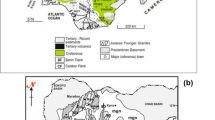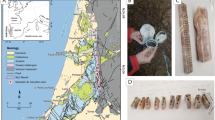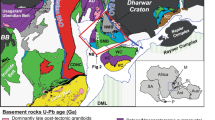Abstract
The precise dating of mineral deposits has important implications for understanding the lifetime of ore-forming systems and their temporal relationship to various geological events. Not all deposits provide material suitable for conventional radiometric dating, or data which are amenable to unequivocal interpretation. Nor is it easy to verify that such samples have remained isotopically ‘closed’ since their formation. Fluid inclusions provide an alternative ‘closed system’ approach. By analysing the isotopic composition of Rband Sr in inclusions within quartz from the Carrock Fell tungsten vein deposits, Cumbria, we demonstrate here the feasibility of obtaining Rb–Sr fluid inclusion isochrons. The age for the mineralization 392 ± 5 Myr is in good agreement with the mean K–Ar age 387 ± 6 Myr for the vein micas, and confirms the significance of fluid inclusions as precise Rb–Sr geochronometers.
This is a preview of subscription content, access via your institution
Access options
Subscribe to this journal
Receive 51 print issues and online access
$199.00 per year
only $3.90 per issue
Buy this article
- Purchase on Springer Link
- Instant access to full article PDF
Prices may be subject to local taxes which are calculated during checkout
Similar content being viewed by others
References
Roedder, E. & Skinner, B. J. Econ. Geol. 63, 715–730 (1968).
Lokerman, A. A. Mineralog. Sb. L'vov 16, 312–317 (1962).
Kerrich, R. Contr. Miner. Petrol. 59, 195–202 (1976).
Skinner, B. J. in Geochemistry of Hydrothermal Ore Deposits (ed. Barnes, H. L. ) 1–21 (Wiley, New York, 1979).
Shepherd, T. J., Beckinsale, R. D., Rundle, C. C. & Durham, J. Trans. Instn Min. Metall. 85, B63 B73 (1976).
McMahon Moore, A. J. J. R. Sch. Mines 26, 7–14 (1977).
Ermakov, N. P. in Int. Ser. Monogr. Earth Sci. 22, 30–41 (1965).
Roedder, E. in Geochemistry of Hydrothermal Ore Deposits (ed. Barnes, H. L. ) 684–731 (Wiley, New York, 1979).
Faure, G. in Principles of Isotope Geology (ed. Faure, G. ) 68–70 (Wiley, New York, 1977).
Williamson, J. H. Can. J. Phys. 46, 1845–1847 (1968).
Wadge, A. J., Gale, N. H., Beckinsale, R. D. & Rundle, C. C. Proc. Yorks. geol. Soc. 42, 297–305 (1978).
Brown, P. E., Miller, J. A. & Soper, N. J. Proc. Yorks. geol. Soc. 34, 331–342 (1964).
Plimer, I. R. & Elliot, S. M. J. Geochem. Explor. 12, 21–34 (1979).
Ashley, R. P. & Silberman, M. L. Econ. Geol. 71, 904–924 (1976).
Taylor, H. P. Jr J. geol. Soc. Land. 133, 509–558 (1977).
Halliday, A. N. Econ. Geol. 75, 752–759 (1980).
Author information
Authors and Affiliations
Rights and permissions
About this article
Cite this article
Shepherd, T., Darbyshire, D. Fluid inclusion Rb–Sr isochrons for dating mineral deposits. Nature 290, 578–579 (1981). https://doi.org/10.1038/290578a0
Received:
Accepted:
Issue Date:
DOI: https://doi.org/10.1038/290578a0
This article is cited by
-
Progressive crushing 40Ar/39Ar dating of a gold-bearing quartz vein from the Liaotun Carlin-type gold deposit, Guangxi, southern China
Scientific Reports (2022)
-
Evolution of a hydrothermal fluid-rock interaction system as recorded by Sr isotopes: A case study from the Schwarzwald, SW Germany
Mineralogy and Petrology (2009)
-
Rb-Sr isotopic chronology of the Au-bearing quartz veins in gold deposits in the eastern part of north China platform
Chinese Journal of Geochemistry (2002)
-
Sr isotope constraints on the age and source of ore-forming materials of gold deposits, southwestern Hunan
Chinese Journal of Geochemistry (2000)
-
40Ar-39Ar dating by crushing technique on a quartz sample from the dongchuan copper deposits in Yunnan, SW China
Chinese Science Bulletin (1998)
Comments
By submitting a comment you agree to abide by our Terms and Community Guidelines. If you find something abusive or that does not comply with our terms or guidelines please flag it as inappropriate.



